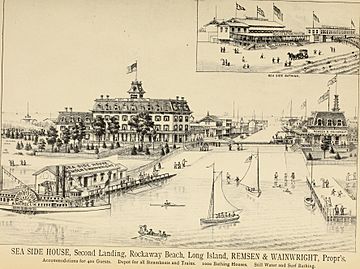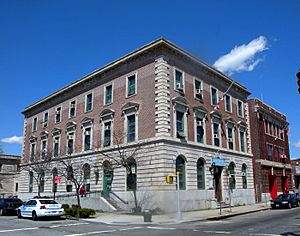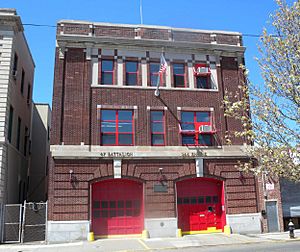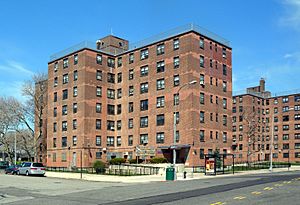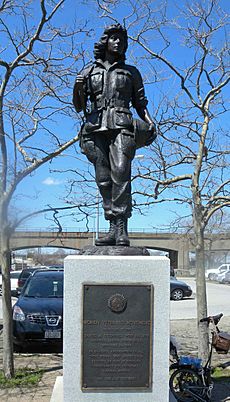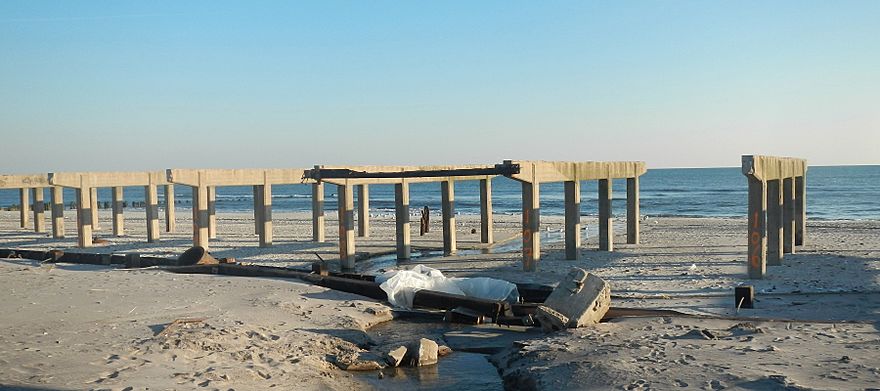Rockaway Beach, Queens facts for kids
Quick facts for kids
Rockaway Beach
|
|
|---|---|
|
Neighborhood of Queens
|
|
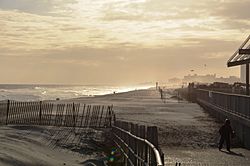
Rockaway Beach in 2013
|
|
| Country | |
| State | |
| City | |
| County/Borough | |
| Community District | Queens 14 |
| Population
(2010)
|
|
| • Total | 13,449 |
| Ethnicity | |
| • White | 59.2% |
| • Black | 29.3% |
| • Hispanic | 14.5% |
| • Asian | 2.0% |
| • Other | 5.9% |
| Economics | |
| • Median income | $37,248 |
| Time zone | UTC−5 (EST) |
| • Summer (DST) | UTC−4 (EDT) |
| ZIP Code |
11693
|
| Area codes | 718, 347, 929, and 917 |
Rockaway Beach is a fun neighborhood in the Queens area of New York City. It's located on the Rockaway Peninsula. To its east is Arverne, and to its west is Rockaway Park.
The neighborhood gets its name from the Rockaway Beach and Boardwalk. This is the biggest city beach in the United States! It stretches for many miles along the Atlantic Ocean. About 13,000 people lived here in 2010. Rockaway Beach is also called the "Irish Riviera." This is because many people of Irish American background live here.
Contents
A Look Back in Time
How Rockaway Beach Began
What we know as Rockaway Beach today used to be two smaller areas. They were called Holland and Hammels. In 1857, Michael P. Holland bought land and named it after himself. Later, Louis Hammel, who came from Germany, bought land next to Holland.
In 1878, Hammel gave some of his land to a railroad company. This helped build a train station for the area. The place around the station became known as "Hammels." On June 11, 1897, Holland and Hammels joined together. They officially became the Village of Rockaway Beach.
Just one year later, it became part of the City of Greater New York. This made it part of the new borough of Queens. However, the people of Rockaway Beach tried to leave the city several times. They wanted to be their own town again. In 1915 and 1917, a bill to let them leave passed. But the mayor, John Purroy Mitchel, said no.
Early Fun and Rules
In the early 1900s, the new train station changed everything. It made the beach easy to reach for everyone, not just the rich. Fun parks, shops, and hotels opened up. People from all over the city came to visit for a day or even a whole summer. Many parts of the area were built by James S. Remsen and William Wainwright. During this time, Rockaway Beach was called "New York's Playground."
A famous amusement park, Rockaways' Playland, opened in 1901. It quickly became a huge hit. As more people came, there were new rules for swimming. In 1904, the police chief, Louis Kreuscher, made rules for beachgoers. These rules covered what bathing suits people could wear. They also said where photos could be taken. Women in bathing suits were not allowed to leave the beach area.
The park was amazing for its time. One popular ride was the Atom Smasher roller coaster. It was even shown in a movie called This is Cinerama in 1952. The park also had a huge swimming pool and a fun midway. These attractions served the community for over eighty years.
The Temple of Israel Synagogue was built in 1921. It was added to the list of important historical places in 2014.
Changes from the 1930s to 1960s
In the 1930s, Robert Moses became a powerful city planner. He built many roads and transportation projects. These projects helped Rockaway Beach in some ways, but also caused problems. Moses ordered the building of the Marine Parkway-Gil Hodges Memorial Bridge and the Cross Bay Veterans Memorial Bridge. These bridges were finished in 1937 and 1939.
The Marine Parkway Bridge connected the isolated communities to Brooklyn. The Cross Bay Bridge landed right in the middle of Rockaway Beach. This new bridge made Rockaway Beach the main way to get to Queens by car.
The bridges helped turn Rockaway Beach into a place where people lived all year. It became a commuter town. People could now travel more easily to and from work. Also, the old train line was changed into a subway line. This also brought more permanent residents to Rockaway.
Even though the bridges were meant to help, some of Moses's other plans caused issues. One plan that didn't fully happen was the Shore Front Parkway. This was supposed to be a highway through the Rockaway Peninsula. The idea was to connect different bridges. Many people worried this big project would harm the peninsula. They saw how other communities had to move their homes because of Moses's road building.
Moses never finished his highway, but he did build a part of it. This section was built in 1939. Some houses were actually cut in half to make way for the four-lane road. Some of these half-houses are still there today! People call this unfinished road the "road from nowhere to nowhere." It doesn't really connect to other major roads.
Robert Moses also built other fun places like the New York Aquarium and Jones Beach State Park. These new places drew tourists away from Rockaway Beach. With fewer visitors, businesses and hotels closed. By the 1950s, the area faced money problems. It was hard for the area to change from a summer vacation spot to a full-time neighborhood.
To help the neighborhood, the city built the Hammel Houses. This was a project to create affordable homes. The city bought the land in 1952. In 1964, they decided to tear down and rebuild the area.
Another housing project, the Dayton Beach Park Cooperative, was built. These tall, rectangular buildings were placed close to the beach. They were finished by the end of the 1960s. Similar buildings like Surfside Park Apartments and Dayton Towers West were built nearby. These tall buildings still stand out in Rockaway Beach today.
The Rockaway Courthouse was built in 1931. It was used as a local court. It stopped being used as a city building in 1962. It was also added to the National Register of Historic Places in 2014.
Rockaway Beach Today
In the early 2000s, more people started moving to New York City. Rockaway Beach became a popular spot for day trips. A magazine even featured it as a place for "Surfing" and "scuba diving for sunken ships."
Some people started calling the beach "Williamsburg on the Rockaways." This was because surfers from the Brooklyn neighborhood of Williamsburg would spend their summers there.
In late 2012, Hurricane Sandy caused a lot of damage to the community. Rockaway Beach began to rebuild. In 2013, the first step was to add a lot of sand back to the beach. This cost $10 million. The second step in 2014 added even more sand, costing about $37 million. The United States government helped pay for this rebuilding after the hurricane.
Who Lives Here?
Based on information from 2010, the total population of Breezy Point, Belle Harbor, Rockaway Park, and Broad Channel was 28,018. This was a small increase from 2000.
Most people in these neighborhoods are White (78.3%). There are also African American (7.5%), Asian (2.1%), and other groups. About 10.8% of the people are Hispanic or Latino.
Rockaway Beach is famous for its large Irish American population. That's why it's called the "Irish Riviera." In 2000, about 25.4% of people in the Rockaway Beach area said they had Irish family. This makes it one of the most Irish places in the whole country!
Learning in Rockaway Beach
The New York City Department of Education runs the schools in Rockaway Beach. Kids living here usually go to P.S. 183 for elementary school. They then go to P.S. 225 for middle school.
There are also two private Catholic elementary schools: St. Camillus and St. Rose of Lima.
For high school, students in New York City apply to different schools. There isn't a high school right in Rockaway Beach. But there are four high schools in one building nearby. They are all part of the Beach Channel Educational Campus.
Getting Around
You can get around Rockaway Beach using local buses. The Q22 and Q35 buses serve the area. The Q53 SBS is a faster bus. There's also the QM16 express bus that goes to Manhattan.
The subway stations in the neighborhood are Beach 90th Street and Beach 98th Street. These are served by the A S trains train. The Q35 bus connects to the Flatbush Avenue – Brooklyn College subway station (2 and 5 train) in Midwood, Brooklyn. The Q53 SBS connects to the 61st Street – Woodside subway station (7 <7> trains) and the Woodside LIRR train station in Woodside.
In May 2017, a new NYC Ferry service started in Rockaway. It docks at 108th Street and Beach Channel Drive. This ferry makes it easier for people to travel to Rockaway from Manhattan or Brooklyn.
Famous People from Rockaway Beach
- Skip Campbell (1948-2018), a Florida politician and mayor, was born here.
- Michael "Iz the Wiz" Martin (1958–2009), a famous graffiti artist from early New York graffiti.
- Jonathan Monaghan (born 1986), a visual artist, grew up in Rockaway Beach.
- Patti Smith (born 1946), a punk rock singer and poet, wrote about living in Rockaway Beach in her book M Train.
- Kenny Vance (born 1943), a singer-songwriter and producer.


